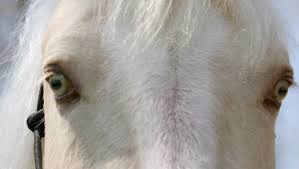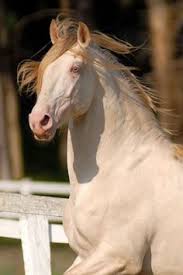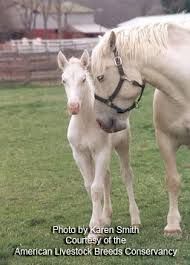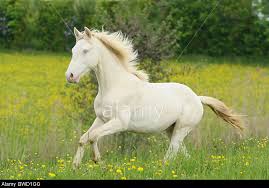BASE, SINGLE & DOUBLE DILUTE COAT COLOURS EXPLAINED
Fundamental Genetics:
Horse coat colour genetics is an interesting, complicated, and sometimes confusing subject! As more research is carried out we gain a greater understanding as to how, why, and where some of the more unusual coat colours stem from.
This is a simplified explanation, which I hope will dispel some of the myths surrounding foals born with unusual coat colours. A horse possesses 32 pairs of chromosomes in each cell, which carries unique information from generation to generation. Both the stallion and the mare’s genetic contribution is equal. When conception takes place genes are not lost or diluted in any way but combined. Horses can be described as either:
HETEROZYGOUS: means the horse possess two forms of a particular gene encoding some inheritable characteristic, which may therefore produce offspring differing from their parents and each other in that characteristic. These horses possess one masking gene (the dominant gene) and one hidden gene (the recessive gene). Because the recessive gene is hidden the horse will appear exactly like a homozygous horse.
HOMOZYGOUS: means the horse has two identical genes at the same place on two corresponding chromosomes. When a homozygous dominant horse is bred to a recessive horse (which by definition is always homozygous), all progeny will look like the homozygous dominant parent, but unlike the parent they will be a carrier (heterozygous) for the recessive gene.
The phenotype (outward coat colour appearance) can be the same with two horses but their genotype (genetic makeup and the information carried by the genes in the cells) can differ. Because the recessives are unknown it can be difficult to determine the outcome of coat colour. Unless we know the birth colour of the sire and dam and understand the reasons why a coat colour occurs the resulting foal colour will be difficult to determine. The only 100% reliable decision is to have a blood test or hair sample test to confirm the genetic makeup of each parent to eliminate guess work and so the ‘chance factor’.

Base colours (C+C+)
There are only two basic coat colours, black (fading and non fading), and red (chestnut). Black, bay, brown and chestnut are called base colours. A base coat colour can only be diluted to a single dilute (C+Ccr) to produce a buckskin (called dun in Ireland) or palomino if a diluting gene is introduced in the absence of other modifying genes. A horse of a base colour does not carry the diluting gene so can never produce a BEC. For example if you bred a BEC mare to a bay or brown stallion the foal will be buckskin. If the same BEC mare is bred to a chestnut the foal will be 100% palomino every time. In general lighter colours are dominant over darker colours. Red (chestnut) is the most recessive colour followed by black. Light bay is dominant over bay, which is dominant over brown, which in turn is dominant over black. All other coat colours are determined by the addition, alteration or absence of these base colours.
Sometimes a horse looks black but in reality is the darkest form of buckskin and so is classified as a single dilute. Unless this horse tests negative for the BEC gene you may have a surprise when breeding!
DILUTE COLOURS:
Buckskin and Palomino are called single dilutes (C+Ccr) and each carry the diluting gene that can produce a BEC.
Dun (DD) and Buckskin (C+Ccr) compared
*The term dun used in Ireland is called a buckskin in other countries.
*There is a difference between the genetic makeup of a dun and a buckskin.
*A buckskin is denoted by the symbol C+Ccr and carries a single diluting gene where as a dun is denoted by the symbol DD and can never produce a BEC..
*Dun can be a breed as it can breed pure and will never produce a BEC.
*The dunning gene is dominant and affects all base colours without tending to lighten the legs or front of the face and leaves a darker mask.
*Duns have what are known as primitive markings. Failure to have a well defined dorsal stripe (a stripe along the spine extending into, and matching, the main and tail), and at least one other matching primitive marking like zebra marks on upper legs, or stripes or mottling on other parts of the body means it is not a D-genotype and more likely to be a buckskin (C+Ccr) and a carrier of the single dilute mechanism whichcan produce a BEC.
*Confusingly, some buckskins have a faint dorsal stripe – these are known as linebacked buckskins.
*Buckskins however never have primitive markings.
*Buckskin bred to buckskin or palomino, and some greys can produce a BEC.
*Buckskin is best bred to a base colour and will produce a buckskin, palomino, chestnut, bay, brown or black, depending on which base colour it is bred to – but will never breed a BEC.
*Buckskins bred from a palomino parent will often have some white hair at the base of the tail and sometimes in the main – known as frosting.
*Buckskin can never become a breed as it cannot breed true. It is only a coat colour.
Palomino: genotype: C+Ccr
*A palomino like a buckskin is a single dilute. It occurs when a chestnut coat colour is diluted by the action of one diluting gene.
*A palomino should never be bred to another single dilute like buckskin or palomino.
*Palomino bred to grey can produce a BEC unless the grey tests negative for the diluting gene.
*Palomino bred to chestnut produces 50% palomino and 50% chestnut.
*Palomino bred to a base colour will produce similar coat colours like the buckskin but never a BEC.
*Palomino can never become a breed for the same reasons as buckskin. It is only a coat colour.
Double dilutes, pseudo-albino CcrCcr
Blue eyed cream (BEC), cream, psuedo-albino, shiny eyes and cremello are some of the terms used in Ireland, and in other countries, to describe ponies and horses born with pinkish skin (sometimes called pumpkin), off white to cream coloured coats, and pale blue eyes that can appear pink in some light. Other less known terms include perlino, smoky cream or smoky perlino which all look similar except for subtle differences in colour due to the base colour the cream gene is acting on. The genetic mechanism (CcrCcr) which produces these coat colours is called a double dilute and can only occur when both the sire and the dam carry the Ccr gene. Sometimes the BEC has been called an albino which is completely incorrect as albinism does not exist in equines. A true albino has no skin/melanin pigment and can have hearing and sight problems. The term suedo-albino is a form of partial albinism which means they do posses pigment but not as much as other coat colours. A BEC’s eyes, just like a human with blue eyes, will be more light sensitive but no records that I have read so far report blindness. A worldwide survey was carried out in 2000 by the BEC Study Committee (email: mewatson@earthlink.net) via questionnaires to fifty-five connemara owners covering important questions like: light sensitivity, hearing, sight, melanoma, medical problems, rashes, hardiness etc. The results were nearly 100% positive with no one reporting any problems other than some of the BEC’s experiencing nose rash and slight light sensitivity with their pale eyes. Nose rash can occur from sunburn or sensitivity to irritants where any horse with a pink mussel is grazing.
Grey (GG)
Grey horses can be a very grey subject as the colour describes!
*Grey is not a true colour but rather an admixture of light and dark hairs superimposed over the horses entire body, which gradually lighten with age.
*The hair follicle of a grey horse is supposed to be, not only defective, but also not as deep-rooted in the dermis as other horses hair follicles, which is the reason why some people believe, they ‘grey out’, usually by the time they reach 6-8 years of age.
*Greys are more susceptible to melanomas, than other coat colours including BEC’s, of which 95% of cases are benign. However grey horses do suffer from gradual depigmentation usually around the eyes and mussel.
*Grey masks all other coat colours and causes many surprises in the horse-breeding world if the parents are not tested for the diluting gene.
*The birth colour of a foal whom is likely to turn grey should always be recorded as this is an indication of a foals true colour and will help determine how the horse will breed in the future. If for example a foal is born black, chestnut, bay or brown it should not carry the diluting gene and therefore will not breed a BEC foal. If on the other hand a foal is born buckskin it will carry the diluting gene and can breed a BEC foal if bred to another horse caring the dilute gene.
*If a grey shows speckled of fleabitten marks, (red speckles=chestnut; black=black; yellow=dun, buckskin, or palomino) in his coat, this is an indication of the true coat colour/birth coat colour and a guideline for breeders in choosing a correct mate.
*Every grey horse should be tested for the diluting gene CcrCcr to avoid the chance breeding of a BEC.
Conclusion
For the duration of the BEC ban, which spanned almost thirty years, the percentage of buckskins in the connemara breed has approximately halved, and the number of connemaras with grey coat colours has increased from approximately 50% to 70%. Black, chestnut, roan and palomino coat colours have reduced from approximately 10% to 3% since 1960.
Quote from Deidre Feely’s report of 2003:
‘The increase in the proportion of grey ponies in the population over the past few decades has been coupled by a decline in the percentage of dun, brown, black, roan and chestnut ponies. Thus, in recent years, the diversity amoung coat colour in registered Connemara Ponies has diminished’.
I have tried to be as accurate as possible in compiling and writing a simplified insight into how different connemara coat colours are achieved which I hope will give owners and breeders a greater understanding of how, or how not to, breed certain coat colours. There is a place for the BEC mare in breeding the popular buckskin (known as dun in Ireland), if the stallion is chosen wisely!
For anyone interested in exploring the subject further I suggest:
*Horse colour explained by Jeanette Gower
*Wendy Bockman’s website www.doubledilute.com
*Equine Colour genetics by D.P. Sponenberg
*Coat colour genetics by Dr. Ann Bowling
*Coat Colour trends in the Connemara Pony Population in Ireland by Deirdre Feely B. Agr.Sc., Patrick Brophy MVB MRCVS., and Katherine Quinn M. Agr. Sc.
*Characterisation of the Connemara Pony Population in Ireland by Deirdre Feely B. Agr. Sc., Patrick Brophy MVB MRCVS., and Katherine Quinn M. Agr. Sc.
Test to detect the Blue Eyed Gene
It is now possible to have your connemara pony tested in Ireland for the BEC gene through Weatherbys Ireland DNA Laboratory at the Irish Equine Centre, Naas, Co. Kildare. The cost for this service is €30.00 per animal which will be significantly reduced pending negotiations with the Connemara Pony Breeders Society based on future testing of the entire foal crop. The test usually takes between two to three weeks but they will facilitate urgent requests if necessary. Simply ring Laura on 045-875521 or email her on: dnalab@weatherbys.ie with the breeding of your connemara pony.



